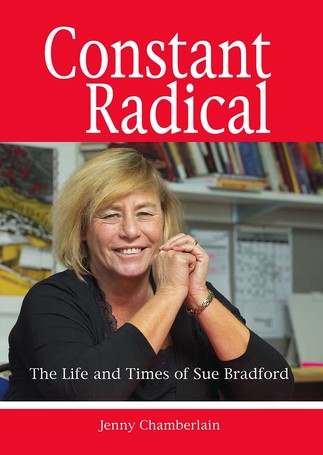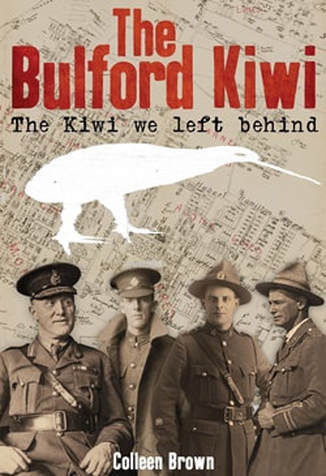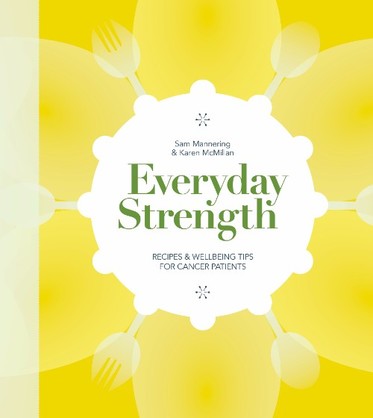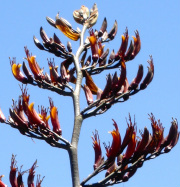
Constant Radical: The Life and Times of Sue Bradford
by Jenny Chamberlain
When I first held this book and felt the weight of its 390 pages I had to wonder – do I want to know that much detail about anyone? And a one-time member of parliament at that – I being adamant in rejecting any political party affiliation. On the other hand, what I knew of this woman urged me to delve deeper.
Deeper revealed a family history with similarities to, and differences from, my own. It is always the differences that intrigue, and these far surpassed the others. Though our lives have been largely contemporaneous, mine felt quite safe and even featureless in comparison.
"Hers was the profile of an educated, 70s middle-class drug-taker: a risk-taking intellectual hippie from a Bohemian background, whose father was addicted to alcohol, who lived in a nest of radicals – which doubled as a crash-pad for all-comers including Vietnam servicemen – and whose favourite pub was the haunt of dealers."
The intrigue increased as details of the life of this woman unfolded. Riches of detail. In the 1950s and ‘60s she is labelled “stroppy and challenging”, “willful and stubborn”, the result of high intelligence and some extraordinary family influences. By age 15 she had an SIS file, sold copies of Mao’s Little Red Book to high school friends, and was a seasoned protester against the Vietnam War even before entering university.
In the following year or two she became even more radicalized, being involved in movements politically, socially, and gender-based.
Motherhood at age 24 brought another facet to her life, one that was to remain central to her being. In the following decades her energies spread to many further issues of social concern, including opposition to nuclear activity, apartheid, the 1981 Springbok tour, Maori sovereignty, poverty. She was involved in movements pro peace, feminism, environment, childcare, housing, employment, both here and overseas. By age 43 she had earned the title “veteran protester”. And all this achieved while bringing up five children!
Then there are the parliamentary years, when she finds herself “a legitimate member of the system she most bitterly opposed”, though also a “rare creature: the ego-free politician”.
This biography is the result of 65 lengthy interviews with Sue, taking place over the best part of a decade, and copious other sources including a long list of other interviewees.
Necessarily, it gives a wider coverage than Sue herself, including details of her missionary forebears and, because of her wide-ranging involvement in so many issues, there are fascinating references to a host of other people well known in this country’s cultural and political life – artists, literary figures, academics, and more. Any New Zealander of any note or notoriety during the mid 20thcentury to the present is likely to get a mention because of some connection to the subject and the causes she espoused. No doubt there’ll be people all over the country who go first to the index to see if and how they are mentioned.
Jenny Chamberlain’s writing is fluent, polished, and definitely not dry to read. Speaker of the House, Lockwood Smith, is said to be “gowned like Gandalf”; some of Sue’s teenage Sundays “were spent in Albert Park – lying on grass and smoking it”.
A useful list of acronyms is given – essential given the references to organizations included – together with a bibliography and index.
By the end of this well-researched work, I felt well rewarded. And much better informed. Had I been asked weeks ago for a one-word summary of this woman, now Dr Sue Bradford, based on my knowledge of her from media sources, I’d have considered ‘formidable’. Yes, she has been a formidable figure in NZ policies and politics, but now I know how she has pushed herself against her basic shy nature, despite poverty, need, attacks both physical and mental, loss, and heartache, to achieve all she has.
It needed all those pages to give a full appreciation. Having read them, it leaves me wondering how one woman has fitted so much into her life. My respects to both the subject and the author.
Author: Jenny Chamberlain
Publisher: Fraser Books
ISBN: 9780994136008
RRP: $39.50 (softcover)
Available: Fraser Books, 53 Essex Street, Masterton; [email protected] or tel: 06 3771359; Nationwide Book Distributors, P O Box 65, Oxford, North Canterbury.



 RSS Feed
RSS Feed
